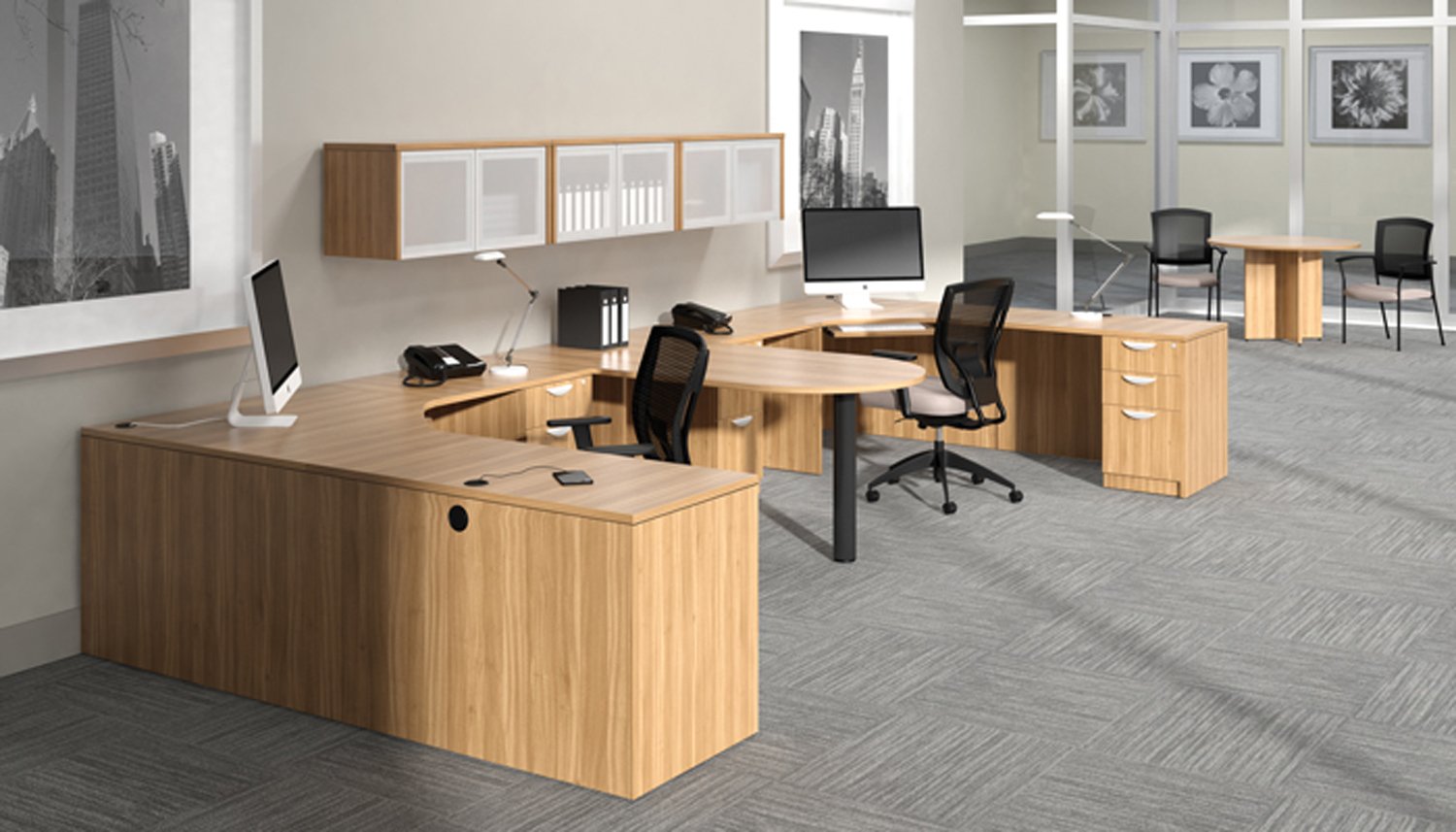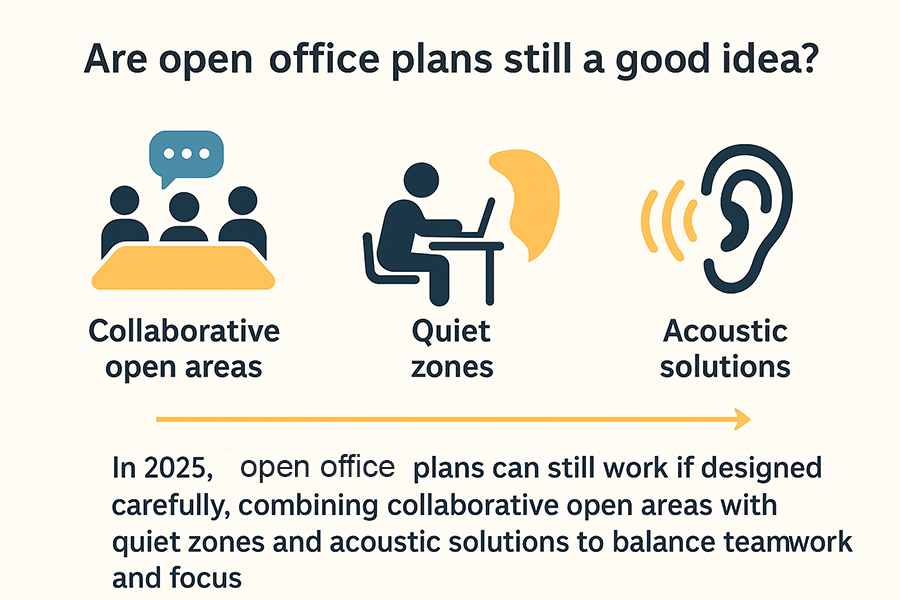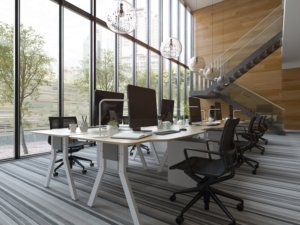Are Open Office Plans Still a Good Idea? [2025]

Over the past 20 years, open office plans have made their way into the mainstream.
Coworking companies like WeWork and tech startups like Google have turned the concept into more of a movement, selling the idea as a way to encourage collaboration.
These designs, which provide a shared space for teams by eliminating walls and enclosed spaces, were initially welcomed as a solution to increase engagement and reduce costs.
Now the question is: Are open office plans still a good idea?
In 2025, open office plans can still work if designed carefully, combining collaborative open areas with quiet zones and acoustic solutions to balance teamwork and focus.
In this article, we explore the pros and cons of open offices, look at the latest workplace design trends, and explore how you can create an optimal and satisfying work environment using hybrid models and flexible spaces.

Back to the Drawing Board? 
The primary concept behind the open-concept office is to facilitate communication, bring teams together, and foster innovation. But in truth, many such offices report lower job satisfaction across the board.
While this might not be the case at every company, the reasons are relatable.
Take, for example, a study conducted by some Harvard researchers who tracked interactions between employees of a Fortune 500 company before and after an office redesign.
The new layout transformed their conventional workspace into an open office, ostensibly, to improve collaboration. Surprisingly, the results showed a massive reduction in face-to-face interactions after the redesign. Email and messaging application use was off the charts, compared to typical usage before the study began.
Unsurprisingly, this seems to be the case with many collaborative office interiors today. You’ll see people working with headphones on, making a concerted effort to block out their surroundings, including their coworkers. Privacy is non-existent, and digital interaction is preferred over the face-to-face kind.
Pros of Open Office Plans in 2025
Despite the challenges and criticisms that open offices face, this type of open office plan can still have significant benefits in some situations, especially when adapted to the modern needs of employees and organizations:
- Enhanced Collaboration: Open office space allows for spontaneous and natural interactions between employees.
Short meetings, quick consultations, and the exchange of ideas are easier to do in person, and teamwork spirit is strengthened.
- Cost Efficiency: By eliminating private rooms and office cubicles, construction, maintenance, and office space costs are reduced.
This advantage is especially important for small and medium-sized companies that have limited budgets.
- Flexibility: Open offices are easily modified and remodeled so that different teams and projects can adjust the space to suit their needs.
This flexibility allows the office to always adapt to changing team sizes or types of work.
- Transparency and Equality: An Open office plan creates a sense of transparency and equality and reduces hierarchical barriers.
Employees feel like they are all on the same level and have direct access to managers or colleagues.
This can increase trust and the spirit of cooperation within the organization.
 Cons of Open Office Plans in 2025
Cons of Open Office Plans in 2025
Although open offices have their own benefits, they also come with challenges and limitations that can impact employee productivity and satisfaction:
- Noise and Distractions: Open office plans are usually associated with more ambient noise, which reduces employee concentration.
Even employees who are naturally social may have difficulty performing tasks that require high levels of concentration.
- Lack of Privacy: In open offices, confidential conversations and individual work are difficult to conduct.
Employees may feel like they are always being watched and cannot work without worrying about their privacy.
- Employee Well-being Concerns: Numerous studies show that open offices can increase stress, fatigue, and even the number of sick days.
Noisy environments without privacy threaten the mental and physical health of employees.
- Potential for Decreased Face-to-Face Interaction: Unexpectedly, open offices sometimes cause employees to turn to digital communication and reduce in-person interaction.
In other words, removing walls doesn’t necessarily lead to more engagement, and some people prefer to rely on email or internal messaging to focus.
The 2025 Workplace Landscape: What Has Changed?
As time passes and the needs of employees and organizations change, office design has also evolved.
In 2025, several main reasons will fundamentally change the shape of the workplace:
- Hybrid Work Models: After the COVID-19 pandemic and the expansion of communication technologies, many companies have adopted hybrid work models.
In this model, employees work part of the week in the office and part from home or other locations.
This trend has led to offices providing space for interaction, collaboration, and group projects.
- Employee Well-being: Organizations now care more than ever about the physical and mental health of their employees.
Work environments that cause stress, fatigue, or lack of focus are no longer desirable to employees.
The design of new offices includes quiet spaces, natural light, break areas, ergonomic office chairs and desks, and amenities that increase employee satisfaction and productivity.
- Technological Advances: New technologies, from collaboration software to space management systems and workplace automation, have enabled greater flexibility and higher productivity.
Digital tools, virtual meetings, and smart office facilities enable employees to engage in group and individual activities without restrictions.
- Moving Towards Flexible and Adaptable Spaces: Considering the diversity of work styles and different needs of teams, modern offices are equipped with multifunctional, adaptable, and customizable spaces.
Movable office desks, private cubicles, quiet areas, rooms with demountable walls, and group collaboration lounges are examples of this flexibility.
The Hybrid Approach: Combining the Best of Both Worlds
Considering the advantages and disadvantages of open office plans and the importance of employee well-being and productivity, the hybrid approach has been proposed as a suitable solution in office design.
This model combines open and private spaces to allow for both collaboration and group interaction while also meeting the need for focus and privacy.
Introduce the concept of hybrid office designs
In hybrid offices, parts of the work environment are designed as open spaces for collaboration and team interaction, alongside private or semi-private spaces for individual work, confidential meetings, and employee breaks.
This combination allows employees to choose the appropriate environment depending on their type of activity.
Benefits of using hybrid spaces
Studies and recommendations from workplace design experts show that adding the following features can significantly improve employee work experience:
- Quiet Zones: Dedicated spaces for concentration and individual work, without environmental distractions.
- Soundproof Pods: Small, soundproofed rooms for confidential conversations or short meetings.
- Flexible Meeting Spaces: Adaptable environments for holding team or group meetings of various sizes.
According to real-world experiences, various companies around the world have been able to simultaneously increase employee productivity and satisfaction by designing hybrid offices.
These companies typically use open spaces for team interactions, and cubicles and private spaces for focused and confidential work.
This model has given employees a sense of greater flexibility and control over their work environment, increasing the organization’s overall productivity.
Expert Opinions
Given the widespread changes in office design and the increasing importance of employee well-being and productivity, many workplace design experts and companies have shared their experiences to show how better results can be achieved by choosing the right office models.
Experts emphasize that a workspace should be conducive to both team collaboration and individual focus. According to professional designers:
- Combining open and private spaces increases employee productivity and satisfaction.
- The use of quiet zones, soundproof pods, phone booths, and flexible meeting spaces is important to the success of hybrid offices.
- The work environment should be changeable and adaptable to the different needs of employees and projects.
The Case in favor of the Open Office
 In reality, you can’t paint all open-concept office situations in the same light.
In reality, you can’t paint all open-concept office situations in the same light.
The open office can represent a significant value proposition for a company, reducing costs and eliminating wasted space in favor of a more flexible approach.
Could it be that the demise of today’s open-concept office is much like its 1940s predecessor?
One theory has it that companies started trying to cram too many people into the open space, creating chaos and reducing productivity. Another point at office furniture itself is the culprit, as the cubicle, designed to bring order, was responsible for feelings of isolation, depression, and chronic pain.
Similarly, collaborative workspace furniture may help the open office rise above it all, providing companies with innovative ways to facilitate interaction without compromising productivity.
To learn more about what collaborative Houston office furniture can do for you, reach out today to set up a free consultation.
Conclusion
After examining the pros and cons of open offices and analyzing new workplace trends in 2025, we can say that open offices can still increase team collaboration, rapid interactions, cost savings, and a sense of transparency and equality.
On the other hand, this type of design can cause increased noise, lack of privacy, stress, and reduced employee concentration.
However, expert opinion and case studies show that open office plans can still be effective, provided they are designed carefully and intelligently.
The use of quiet zones, sound booths, hybrid and flexible spaces can reduce the problems of traditional open offices and provide a better work experience for employees.
Therefore, as a business manager, you must consider the specific needs of the organization and the preferences of your employees when choosing an office design.
Because there is no one-size-fits-all model for all organizations, the best results are achieved when the office design is tailored to the work style, projects, and organizational culture.
Overall, the answer to the question of whether open offices are still a good idea depends on the balance between collaboration, focus, and employee well-being, and with functional design, the benefits can be reaped without being negatively impacted by the disadvantages.
To have a perfect Office Space Planning for your open office, contact us now!

John Ofield is the owner of Collaborative Office Interiors. Houston’s trusted source for modern and commercial office furniture, office cubicles, demountable walls, office desks and tables, and complete workspace solutions. With more than 40 years of experience, he combines deep product knowledge with hands-on space-planning expertise to create ergonomic, productivity-focused work environments for businesses across Southeast Texas.


 Cons of Open Office Plans in 2025
Cons of Open Office Plans in 2025

